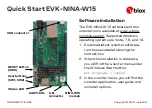
Wiring inputs and outputs
TruVu™ VVTZC
-E2
©2022 Carrier.
Installation and Start-up Guide
All rights reserved.
60
All of the above except Combination Modulating Baseboard/Staged Electric Heat can be ducted or non-ducted
(baseboard). For ducted heat and Combination Modulating Baseboard/Staged Electric Heat, an SAT sensor
(33ZCSENSAT) must be installed in the duct downstream of the heat source. The controller has a configurable
Maximum Heating SAT
for supply air temperature control. The zone controller monitors the (SAT) when the
terminal’s ducted heat is operating.
If the network provides the OAT, heating can be disabled if the OAT rises above the configured
Heating Lockout
Temperature
.
Modulating Hot Water / Steam Heating Heat
–
The controller modulates a normally closed or normally open hot
water or steam valve connected to the discharge air heating coil. The valve opens and closes as needed to satisfy
the zone's heating requirements. For ducted heat, the terminal’s heat supplements heat from the primary air
source if it is in heating mode and is controlled so that the SAT does not exceed the
Maximum Heating SAT
[90°F
(32.2°C) default]. For baseboard heating (non-
ducted heat), the valve modulates to keep the zone’s temperature
at the heating setpoint.
SCR Electric Heat
–
The controller modulates an SCR heat output connected to the SCR electric heat control
input. The output increases as needed to sa
tisfy the zone’s heating requirements. For ducted heat, the terminal’s
heat supplements heat from the primary air source if it is in heating mode and is controlled so that the SAT does
not exceed the
Maximum Heating SAT
[90°F (32.2°C) default]. For baseboard heating (non-ducted heat), the
SCR heat output modulates to keep the zone’s temperature at the heating setpoint.
Two-Position Hot Water / Steam Heating Heat
–
The controller operates a normally closed or normally open hot
water or steam valve connected to the discharge air heating coil. The valve opens and closes as needed to satisfy
the zone's heating requirements. For ducted heat, the terminal’s heat supplements heat from the primary air
source if it is in the heating mode and is controlled so that the SAT does not exceed the
Maximum Heating SAT
[90°F (32.2°C) default]. For non-
ducted (baseboard) heating, the valve is controlled to keep the zone’s
temperature at the heating setpoint.
Electric Auxiliary Heat
–
The controller operates 1 or 2 stages of e
lectric heat. For ducted heat, the terminal’s heat
supplements heat from the primary air source if it is in the heating mode and is controlled so that the SAT does
not exceed the
Maximum Heating SAT
[90°F (32.2°C) default]. For non-ducted (baseboard) electric heat, the
stages are controlled as needed to keep the zone’s temperature at the heating setpoint.
Combination Modulating Baseboard / Electric Heat
–
The controller can modulate a normally closed or normally
open hot water or steam valve connected to a perimeter baseboard radiation system and control up to 2 stages of
ducted electric heat. The valve modulates to satisfy the zone's heating requirements. If the valve cannot meet the
load, elec
tric heat is used. The terminal’s electric heater supplements
heat from the primary air source if it is in
heating mode and is controlled so that the SAT does not exceed the
Maximum Heating SAT
[90°F (32.2°C)
default].
Parallel Fan Heat On Delay
–
For Parallel Fan terminals only, the controller has a configurable
Parallel Fan Heat
On Delay
to save energy. During the delay (15 minute default), only the fan operates to recycle heat from the
ceiling plenum. If the heating requirement is not met by the end of the delay, reheat is enabled.
Fan Heat Off Delay
–
For fan-powered terminals, the controller has a configurable
Fan Off Delay
. After the heating
coil de-energizes, the fan continues to run for the length of the delay to deliver to the zone any heat stored in the
coil. The default delay of 2 minutes is optimal for ducted hot water coils. For ducted electric heat coils, the
nominal delay is approximately 1 minute. For baseboard and non-ducted heat, the delay should be set at 0.
This feature applies to parallel fan terminals in both occupied and unoccupied mode and series fan terminals in
the unoccupied mode if the air source fan is off.
















































